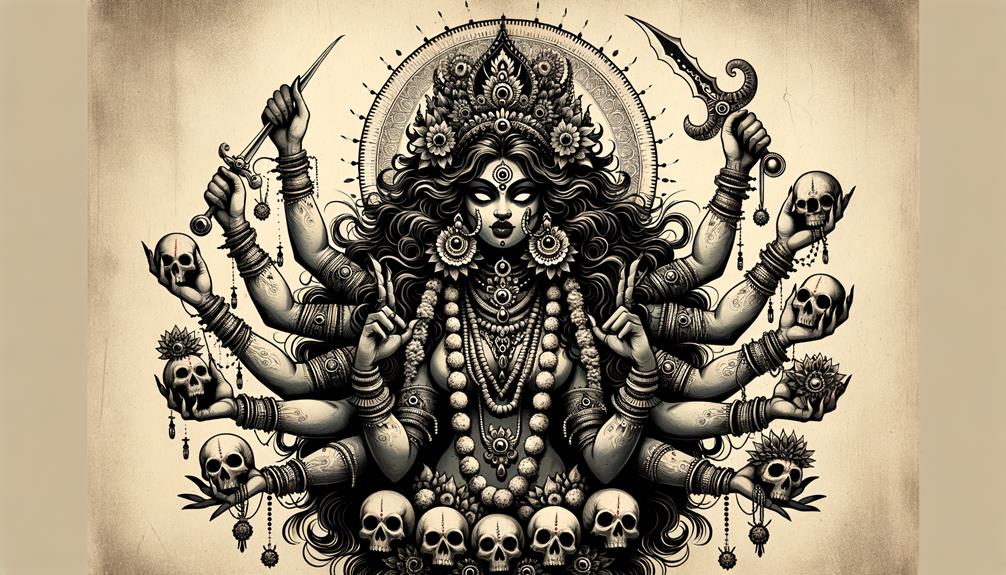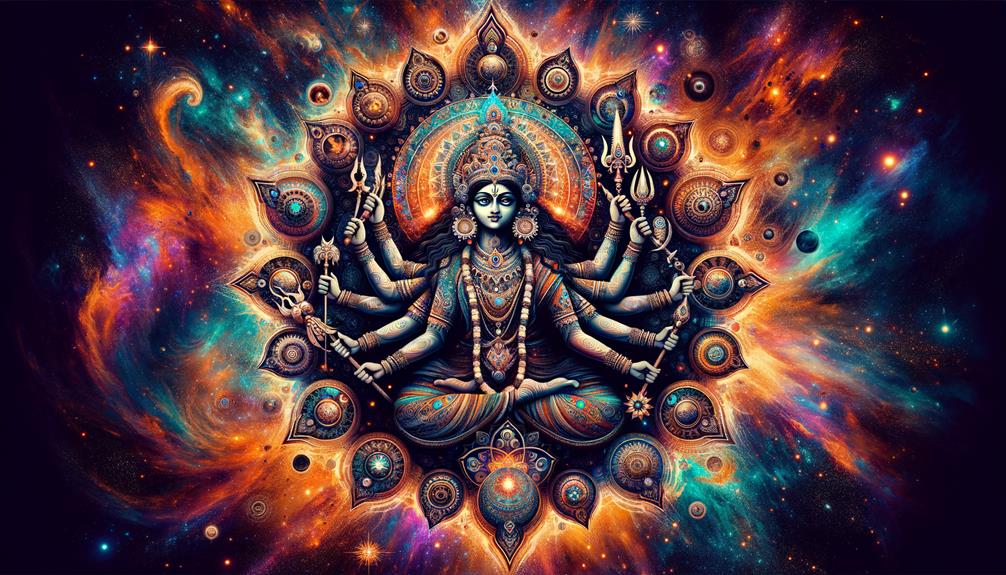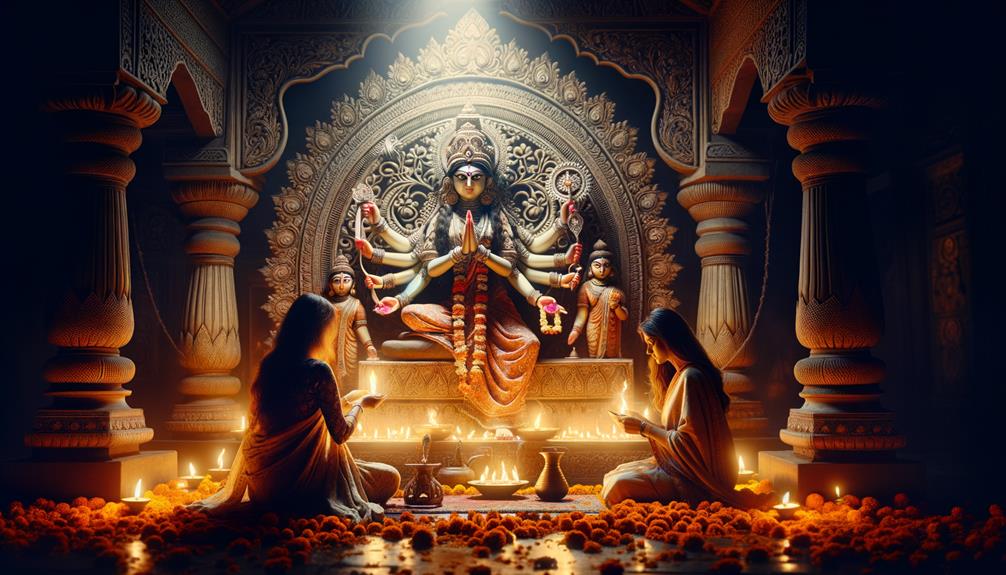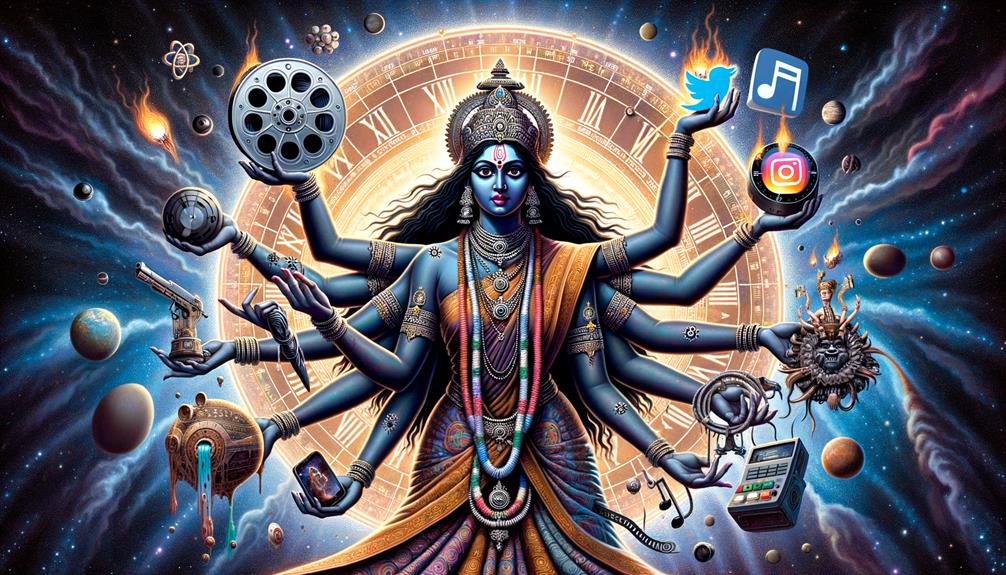Kali: Unraveling the Enigma of the Hindu Time Goddess
As we navigate the vast expanse of Hindu mythology, Kali, the revered Hindu Time Goddess, piques our curiosity and commands our focus. This enigmatic deity, an intricate embodiment of chaos and destruction, simultaneously symbolizes time, change, and creation. Her graphic representation, strikingly potent, diverges sharply from the generally tranquil and benign portrayals of goddesses in other mythologies.
However, a common thread of respect for feminine power interweaves these differing depictions. The paradox of Kali is a fascinating study, and her multifaceted nature encourages us to delve deeper into her narrative, to untangle the rich interplay of mythology, symbolism, and cultural perspectives that envelop this formidable deity. So, let's embark on this enlightening journey, examining the conundrum that is Kali, and see what insights we can unearth.
Kali: A Complex Figure of Chaos and Creation
Kali's iconography, stark and commanding, is a powerful depiction of the dichotomy of creation and destruction. In the landscape of Hindu mythology, her representation is a poignant reminder of the cyclical nature of time and the inevitability of change. Her story is rich with symbolism and serves as a compelling example of the reverence accorded to feminine power in Hinduism.
Insights from Kali's Multi-faceted Nature
The fascinating paradox of Kali is not just her dual nature but also the different interpretations of her persona across cultures. This curiosity invites us to explore her story more deeply, uncovering the intricate tapestry of myth, symbolism, and cultural perceptions that surround this formidable deity.
In conclusion, Kali, the Hindu Time Goddess, is a complex figure, a symbol of chaos and creation, time and change. Her intriguing paradox and multifaceted nature draw us into her world, compelling us to delve deeper and understand her role in Hindu mythology. Through this exploration, we gain a greater appreciation for the powerful feminine figure that Kali represents, and the insights gleaned from her story can help us better understand the rich tapestry of Hindu mythology.
Understanding Kali's Origins

Unveiling Kali's Genesis
Delving into Kali's genesis, we uncover her roots in the non-Vedic, tantric tradition. She possibly hails from the pre-Aryan age and is acknowledged as one among the ten sublime Mahavidyas in the enthralling Hindu tantric custom. As the Hindu deity Kali, she embodies the essence of time, an intriguing acknowledgement of the feminine form of Kāla, the Hindu term for 'time' or 'fullness of time'. Her creation narratives, immersed in the vibrant Hindu religious culture, provide a captivating glimpse into the annals of the world.
Kali in Devi Mahatmyam: A Unique Depiction
Contrastingly, Kali's portrayal in the Devi Mahatmyam is distinctive. In this text, she emerges from Vishnu's body to shield the world from malevolent spirits, an essential Hindu narrative underscoring her safeguarding nature. Durga summons her to combat the demon Raktabīja, further cementing her status as a formidable entity.
Kali's Formidable Avatars: An Analysis
Examining her two main avatars, the four-armed and the ten-armed Mahakali, we observe her venerated as one of the ten Mahavidya manifestations of Adi Parashakti. This recognition reinforces her prominence within the Hindu tradition. Remarkably, her worship even extended to the West through the Romani communities.
*"Kali, the embodiment of time, has a complex and rich history in Hindu tradition. Her protective nature, formidable force, and extensive worship highlight her significant role across cultures."*
Incorporating these fascinating aspects of Kali's mythology into your understanding of Hinduism will enrich your knowledge and appreciation for this vibrant and influential religion. This exploration of Kali's origins and forms offers a comprehensive look at one of Hinduism's most captivating deities.
Iconography and Symbolism

Understanding Kali: Unraveling the Symbolism and Iconography of the Hindu Goddess
Delve into the intricate iconography of Kali! The pulsating imagery of this Hindu goddess of death – her black or blue skin, disheveled hair, and multiple arms – paints a vivid picture of life's cyclical nature. Her attire, a skirt crafted from human arms, serves as a potent symbol of this cycle. Let's journey deeper into the profound symbolism and iconography of Kali.
The Union of Energy and Consciousness
Kali statues commonly depict her standing on Shiva, a portrayal that signifies the unification of dynamic energy (Kali) and passive consciousness (Shiva). This visual representation is a profound illustration of the Hindu belief where Parvati merges with Shiva, creating a harmonious balance of feminine and masculine energies.
A Garland of Liberation
Kali's garland of human heads is not merely an ornament. It symbolizes liberation from ego and underscores her transformative role as a goddess. This particular iconography emphasizes her power to stimulate personal growth and spiritual evolution.
Ten Arms of Divine Power
In her ten-armed form, Kali embodies divine powers. This iconography serves as a symbolic reflection of her fierce nature in battle, highlighting her role as a protective deity.
Kali Yantra: A Symbol in Tantra Yoga
Kali's symbol in Tantra Yoga is the Kali Yantra, an intricate geometric design utilized in meditation. This symbol transcends religious boundaries, serving as an emblem of divine energy and focus in diverse spiritual practices.
The study of Kali's iconography extends beyond Hindu and Tantric traditions, evolving into a symbol of Mother Nature and feminine strength across various spiritual movements. To truly understand Kali, one must not only explore the physical representations but also decipher the profound symbolism she embodies.
The Legends and Myths

Understanding Legends and Myths: The Tale of Kali
As we delve into the captivating world of legends and myths, the Goddess Kali emerges as a compelling figure. Rooted deeply within non-Vedic traditions, possibly linked to the pre-Aryan era, her tales are enriched with elements of time, death, and transformation. Let's dive into the narrative ocean to discover the essence of Kali.
Kali's Epic Battle with Raktabija
One of the most riveting myths revolves around Kali's confrontation with the demon Raktabija. The narrative paints a picture of a relentless battle where each drop of the demon's blood gave birth to a new demon. Driven by her tenacity, Kali swallowed these entities and quenched her thirst with Raktabija's blood, halting the birth of any more demons. This story underlines Kali's dual role as both the creator and the destroyer.
| Legend | Interpretation |
|---|---|
| Kali Conquers Raktabija | Kali's role in preserving cosmic order |
| Symbolism of the Severed Head | A tale of transformation and rebirth |
| Kali's Cosmic Dance | The cycle of life and death |
| Kali as a Nurturer | The softer, nurturing side of Kali |
The myths surrounding Kali underscore her as a symbol of rebirth emerging from death. This is often represented through the severed head she is depicted holding, an emblem of ignorance being vanquished by wisdom. Kali's dual nature, as a force of both creation and destruction, resonates with the Hindu belief in the cyclical nature of life. Her tales, steeped in rich symbolism, instill a sense of awe, reverence, and a profound understanding of life's cycles.
In our endeavor to explore and understand these legends and myths, we can gain a deeper appreciation of Kali as a transformative figure. Her stories are not just captivating narratives, but also offer valuable lessons and insights into the cyclical nature of life and death, transformation, and the overcoming of ignorance. These tales, deep-rooted in symbolism, invite us to reflect, learn, and understand the world around us in a more meaningful way.
Worship and Ritual Practices

The Worship of Kali: An Enthralling Voyage Through Rituals and Practices
Dive into the intriguing world of Kali, a fascinating deity who commands a powerful presence in numerous cultures and sects. Unravel her unique worship rituals, which are as diverse and dynamic as her own persona. We will shed light on four key elements that capture the essence of Kali worship:
1. Daily Devotionals****: Kali finds a special place in the daily prayers of numerous Hindu households, especially in Bengal. The chant of Mahishasura Mardhini becomes a crucial component of these daily devotionals.
2. Celebrating Kali Puja****: The Kali Puja festival in Eastern India is a grandiose spectacle honoring Kali Ma as the vanquisher of evil. The celebrated Kalighat Temple is a significant hub for this event, making it a must-visit destination.
3. Historic Human Sacrifices****: Although largely discontinued, there were eras when human sacrifice to Kali was prevalent. Historic texts provide glimpses of this erstwhile practice.
4. Cross-cultural Adoration****: Kali's veneration extends beyond India's boundaries, with Buddhists, Hindus, and Muslims in Sri Lanka paying homage to her.
Kali's worship methods significantly vary across regions and sects, attesting to her far-reaching influence. Her multifaceted persona is reflected in the diverse ways she is worshipped, from intimate daily rituals to grand festivals. This enduring relevance and distinctive worship practices make Kali a deity worth exploring.
Venture into the captivating world of Kali's worship, an experience that is sure to leave you enlightened and inspired. This exploration is not only enlightening but also serves as a testament to the rich and vibrant tapestry of cultural practices that revolve around this powerful deity.
Kali's Influence in Popular Culture

Kali: A Potent Symbol of Power in Pop Culture
Drawing inspiration from a medley of media platforms – literature, cinema, music, and art – the far-reaching impact of Kali is evident. Her profound symbolism and imagery drive narratives of power, destruction, and women empowerment. Kali's representation takes many forms, each offering a unique perspective into her essence. Be it as a warrior goddess, a divine mother, or an emblem of female strength, Kali's influence is vast and varied.
Let's delve into the myriad ways Kali's name and persona permeate popular culture:
| Medium | Representation | Interpretation |
|---|---|---|
| Books | Strong, self-reliant characters | Mirrors Kali's warrior goddess aspect |
| Movies | Enigmatic, powerful entities | Echoes of the Divine Mother |
| Music | Poignant lyrics or motifs | Captures the intricacies of feminine power |
| Art | Distinctive traits and characteristics | Illustrates Kali's dual nature |
| Social campaigns | Icons for women empowerment | Kali as a catalyst for change |
The multifaceted nature of Kali's influence asserts her identity beyond her role as a Hindu Goddess. She stands as a symbol of empowerment and transformation, underscoring the might of the Divine Mother in pop culture.
If you're keen to explore Kali's impact further, consider reading "Kali: The Black Goddess of Dakshineswar" by Elizabeth U. Harding. This book offers a rich insight into Kali's symbolism and her influence on literary characters. For a cinematic perspective, watch "Kali the Mother"—a film that beautifully portrays Kali's powerful presence.
Remember, Kali isn't just a divine figure; she's an embodiment of change and empowerment, making her a relevant and influential figure in popular culture. Her diverse portrayals in various media forms reinforce her significance, making her a fascinating subject to explore.
Frequently Asked Questions
Is Kali the Goddess of Time?
Is Kali the Goddess of Time in Hindu Beliefs?
Absolutely! To understand the role of Kali in Hinduism, one must dive into the deep, spiritual waters of this ancient belief system. Kali is not merely a character in a myth; she is a divine figure embodying the relentless force of time itself. As the Goddess of Time, Kali takes center stage, representing both the genesis and the end of life, thereby signifying the endless cycle of existence.
Kali: A Powerful Symbol of Time
In the intricate tapestry of Hinduism, Kali stands as a vivid symbol, a beacon of time's perpetual motion. She is the embodiment of life's cyclical nature – a potent representation of creation and destruction. This dual role beautifully captures the essence of time, which ceaselessly drives the universe's rhythm, from the birth of stars to their eventual collapse.
Real-World Example: The Eternal Cycle of Day and Night
Consider the daily transition from dusk to dawn. Just as the day gives way to night and night to day, Kali symbolizes the constant ebb and flow of time, reminding us of the inevitable cycle of life and death.
Recommendation: Dive Deeper into Hindu Philosophy
For those keen to explore further, we recommend "Kali: The Black Goddess of Dakshineswar" by Elizabeth U. Harding. This book provides a comprehensive understanding of Kali's role as the Goddess of Time, offering a detailed exploration of her symbolism within Hindu philosophy.
What Is Kali the Hindu God Of?
Unlocking the Mystique: Kali, the Hindu Goddess of Time, Death, and Liberation
Venturing into the profound depths of Hindu mythology, we encounter Kali, a divine entity embodying the relentless march of time and the inevitable end that awaits all life forms – death. However, her symbolism extends beyond this apparent dread, encapsulating a profound concept of liberation from the cycle of rebirth.
Kali is not merely a deity of destruction, but a beacon of liberation from the cyclical nature of existence. Her portrayal often evokes mixed emotions of awe and reverence, reflecting the intricate tapestry of life and death she represents.
The Paradox of Kali: Fear and Admiration
Kali's complex persona, a fusion of seemingly contrasting elements, captivates her followers' minds. Her image, although intimidating, is a testament to the transience of life and the liberation awaiting beyond. The fear she inspires is not just a reaction to her destructive power, but a reflection of the apprehension towards the unknown – the end of life and what lies beyond.
Kali's Symbolism: A Lesson in Acceptance and Liberation
Kali's fundamental teaching is the acceptance of life's fleeting nature and the liberation that comes with this realization. She's a constant reminder that time, the ultimate equalizer, spares no one. Embracing Kali's teachings helps us navigate life's complexities with grace, courage, and a profound understanding of our mortal existence.
As we delve deeper into Hindu mythology and the persona of Kali, we're encouraged to embrace the ephemerality of life and the liberation that awaits us at its end. Her teachings, far from being morbid, are a testament to the liberation that acceptance of our mortality can bring.
In essence, Kali is not just a figure of dread or reverence, but a symbol of life's cyclical nature and the liberation that comes with understanding and accepting it. She is a beacon guiding us towards a life lived with grace, courage, and a profound understanding of our ephemeral existence.
What Is Kali Time?
Understanding the Profound Concept of 'Kali Time'
Kali Time, an intriguing philosophical concept, signifies the ceaseless cycle of creation and dissolution. It embodies the unending flow of time, giving rise to both constructive and destructive forces. This concept mirrors the relentless rhythm of life, showcasing birth, growth, decay, and ultimate demise.
The Ebb and Flow of Life: Kali Time
At its core, 'Kali Time' is an eloquent metaphor for the continuous cycle of life and death. It's a compelling concept that engages us by highlighting the cyclical nature of existence. Just as the seasons change from spring's birth and summer's growth, to autumn's decay, and winter's death, so too does 'Kali Time' represent these universal phases.
The Reality of Constructive and Destructive Forces
'Kali Time' beautifully encapsulates the duality of creation and destruction. For instance, a forest fire, while initially destructive, eventually leads to the birth of new vegetation. Similarly, 'Kali Time' manifests this paradoxical constant flow of time, where destruction paves the way for creation.
Embrace the Rhythm of Kali Time
In essence, 'Kali Time' is a friendly reminder of life's perpetual rhythm. It invites us to accept and appreciate the constant change around us. It persuades us to seize the day, for life is a constant dance of creation and destruction, birth and death.
Kali Time: An Engaging Concept for Life's Endless Cycle
In conclusion, 'Kali Time' is a profound and engaging concept that provides a fresh perspective on the cycle of life. It offers clarity on the ceaseless flow of time, depicting the constructive and destructive forces inherent in existence.
Is Kali Goddess Good or Bad?
Understanding Kali: The Goddess of Destruction and Creation
Is Kali good or bad? The answer isn't as black-and-white as you might think.
To view Kali, the complex Hindu Goddess, through a binary lens of 'good' or 'bad' is an oversimplification. It lacks precision and fails to capture her true essence. A more accurate description would capture her as embodying destruction and creation concurrently.
The Duality of Kali
Kali is a figure that can be terrifying and compassionate at the same time. This duality is what makes her unique. Consider the concept of 'Semantic Triples,' where an entity relates to another in two contrasting ways. For instance, fire can both warm and burn. Similarly, Kali represents both the end and the beginning, the fear and the compassion.
Why It's Important to Understand Kali
To fully appreciate and comprehend Kali, we need to delve into her complexity, not reduce her to a mere binary categorization. Imagine a piece of intricate origami, it's not just about the final product, but the intricate folds and creases that create the whole. Similarly, Kali's persona is shaped by her multifaceted nature.
Kali: Not Just a Goddess, But a Symbol
To better grasp Kali's persona, it's recommended to approach her as a symbol rather than a deity. She's akin to a storm, frightening yet necessary for nature's cycle. It's about understanding her dual role, not just labeling her.
In conclusion, Kali's nature is simultaneously terrifying and compassionate, embodying destruction and creation. It's about embracing her complexity, not confining her in binary terms.

